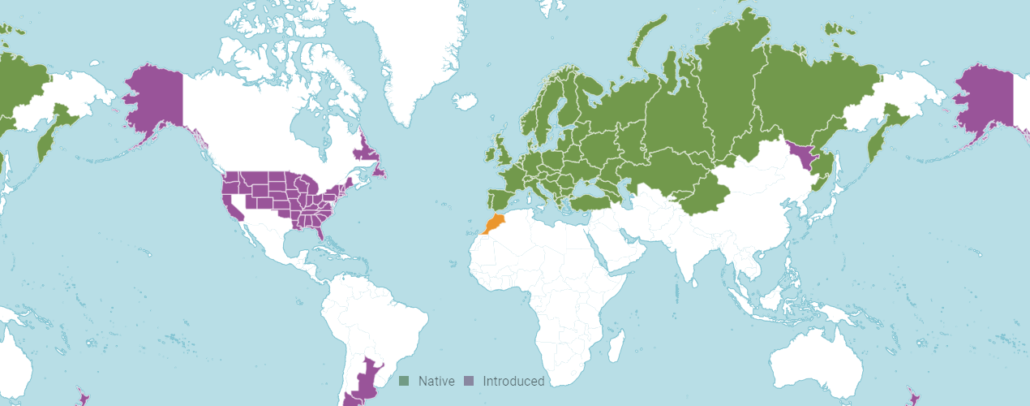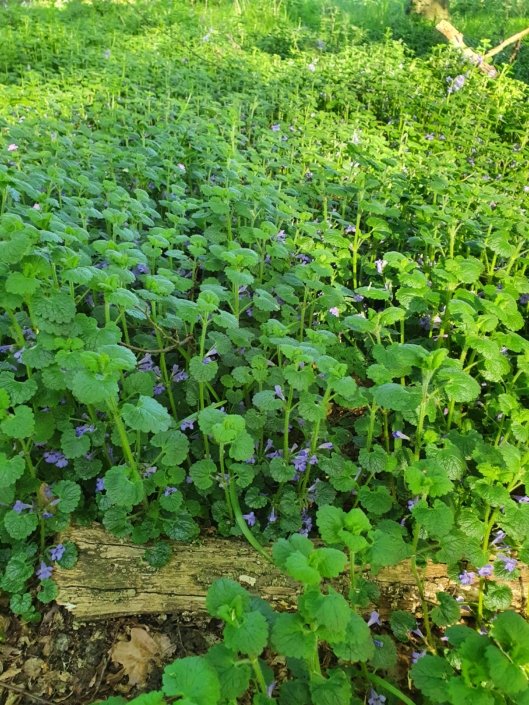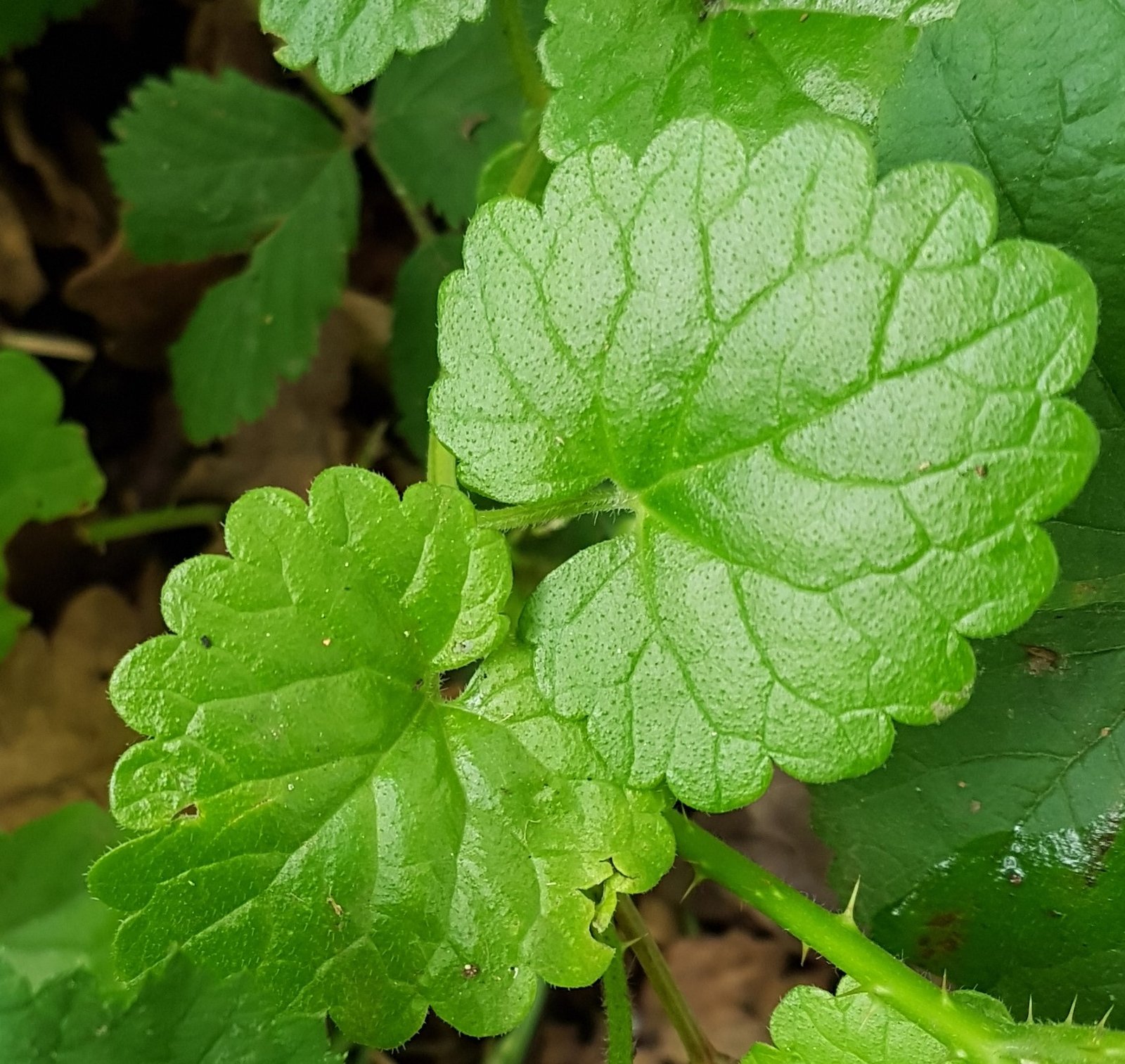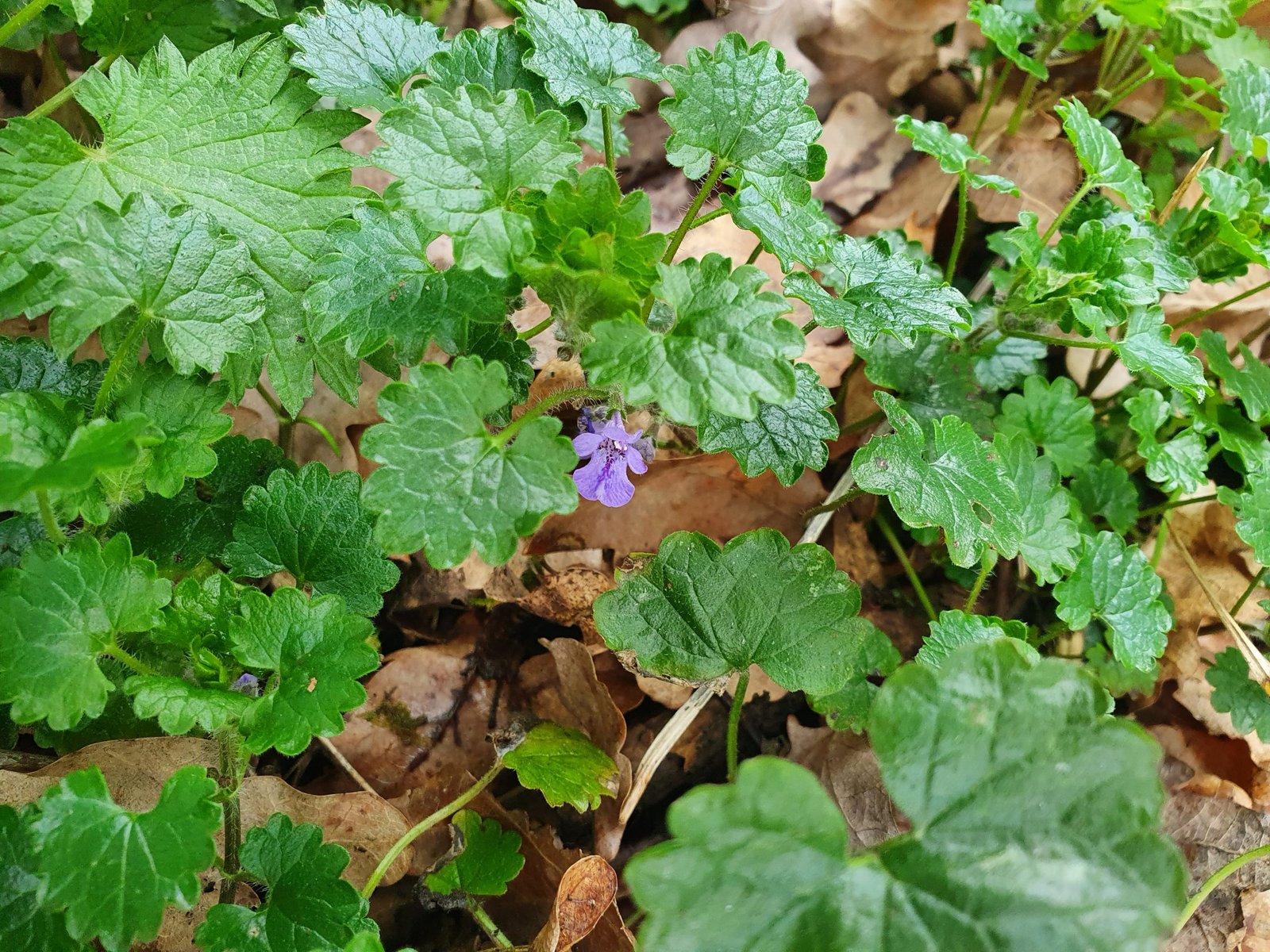Ground Ivy
The taste of Ground Ivy raw is so pungent that it is difficult for most people to chew an entire leaf; However, that flavour mellows considerably on cooking, and so makes an excellent addition for stock, sauces and gravies.
Habitat
Damp waste ground, hedgerows and woodland margins. Most of Europe, including Britain, northern and western Asia to Japan.

Description
Glechoma hederacea is an aromatic, perennial, evergreen creeper of the mint family, Lamiaceae. It thrives in moist shaded areas, but also tolerates sun very well. It is a common plant in grasslands and wooded areas or wasteland. It also thrives in lawns and around buildings since it survives mowing. It spreads by stolons or by seed. Part of the reason for its wide spread is this rhizomatous method of reproduction. It will form dense mats which can take over areas of lawn and woodland and thus is an considered invasive or aggressive weed in suitable climates where it is not native.
Not related to ivy (Hedera helix), its name is usually attributed to the similarity in leaf shape and its behaviour in creeping along the ground.
Identifying Features
- Stem – Square stems which root at the nodes, usually found lying horizontally, although can be found upright.
- Leaves – Round to reniform (kidney or fan shaped), crenate (with round toothed edges) opposed leaves 2–3 cm diameter, on 3–6 cm long petioles. Usually more round toward the end of a stem and more heart-shaped near the base.

- Flowers – The flowers are bilaterally symmetrical, funnel shaped, blue or bluish-violet to lavender with white and dark purple spots on the lower lip, believed to be designed to attract pollinating insects. The flower grow in opposed clusters of two or three flowers in the leaf axils on the upper part of the stem or near the tip. It usually flowers from March to June, then again in the Autumn.

Pictures
Uses
Food
Young leaves – raw or cooked. The leaves have a bitter flavour, they can be mixed into salads to add a slight aromatic tang. They can also be cooked like spinach, added to soups etc or used as a flavouring. Available very early in the year. A herb tea is made from the fresh or dried leaves. It is often used mixed with verbena leaves. The herb has been added to beer in much the same way as hops in order to clear it and also to improve its flavour and keeping qualities.
Glechoma was widely used by the Saxons in brewing ale as flavouring, clarification, and preservative, and later by the English, before the introduction of hops into brewing which changed the ale into beer, in the late 15th century. Thus the brewing-related names for the herb of, alehoof, tunhoof, and gill-over-the-ground.
Glechoma has been used in the cheese-making process as a substitute for animal rennet.
Medicine
Ground ivy is a safe and effective herb that is used to treat many problems involving the mucous membranes of the ear, nose, throat and digestive system4. A well-tolerated treatment it can be given to children to clear lingering catarrh and to treat chronic conditions such as glue ear and sinusitis4. Throat and chest problems, especially those due to excess catarrh, also benefit from this remedy4. The leaves and flowering stems are anodyne, antiphlogistic, appetizer, astringent, digestive, diuretic, febrifuge, pectoral, gently stimulant, tonic and vermifuge5,6,7,8,9. They are best harvested in May whilst still fresh, and are dried for later use10. The leaves are used in the treatment of hypersensitivity in children and are useful in the treatment of kidney diseases and indigestion. Applied externally, the expressed juice speeds the healing of bruises and black eyes5.
Known Hazards
Avoid if pregnant as large quantities can be abortifacient. Contraindicated in epilepsy. Avoid if suffering from kidney disease.
Harvesting
The leaves and flowering stems are best harvested in May whilst still fresh, and are dried for later use medicinally. For food the young shoots, leaves and pre-flowering tips can be harvested all year round.
Potential Lookalikes
Apparently, Glechoma is sometimes confused with common mallow (Malva neglecta), which also has round, lobed leaves; but mallow leaves are attached to the stem at the back of a rounded leaf, where ground ivy has square stems and leaves which are attached in the centre of the leaf, more prominent rounded lobes on their edges, attach to the stems in an opposite arrangement, and have a hairy upper surface. In addition, mallow and other creeping plants sometimes confused with ground ivy do not spread from nodes on stems.
That said, in my experience ground ivy and common mallow aren’t easily confused; Much more likely is possible confusion between ground ivy and garlic mustard (Alliaria petiolata) which has a very similar leaf shape and certainly for beginners can have very similar looking leaves.
Above all looks, ground ivy emits a distinctive odour when damaged, being a member of the mint family.
Mythology and Symbolism
Because it forms long, leafy flowering, trailing stems, it is no surprise that is was often woven into garlands. Such garlands were used to protect cattle (despite it being poisonous to cattle!) and apparently the first milk was passed through a wreath of ground ivy to protect it in some parts of the world.

Sources
- Wikipedia – https://en.wikipedia.org/wiki/Glechoma_hederacea
- PFAF – https://pfaf.org/user/Plant.aspx?LatinName=Glechoma+hederacea
- Chevallier. A. The Encyclopedia of Medicinal Plants Dorling Kindersley. London 1996 ISBN 9-780751-303148.
- Grieve. A Modern Herbal. Penguin 1984 ISBN 0-14-046-440-9.
- Launert. E. Edible and Medicinal Plants. Hamlyn 1981 ISBN 0-600-37216-2.
- Lust. J. The Herb Book. Bantam books 1983 ISBN 0-553-23827-2.
- Polunin. O. Flowers of Europe – A Field Guide. Oxford University Press 1969 ISBN 0192176218.
- Mills. S. Y. The Dictionary of Modern Herbalism.
- Bown. D. Encyclopaedia of Herbs and their Uses. Dorling Kindersley, London. 1995 ISBN 0-7513-020-31.
- Chou ST, Ho BY, Tai YT, Huang CJ, Chao WW. Bidirect effects from cisplatin combine with rosmarinic acid (RA) or hot water extracts of Glechoma hederacea (HWG) on renal cancer cells. Chin Med. 2020;15:77. Published 2020 Jul 29. doi:10.1186/s13020-020-00358-2.
Related
Helper Sites
- The Forager Helper
- The Wild Herbalist Helper (coming soon…)











